[tourist, bungalows during british rule of india]FREE PHOTOS]
Perils of Dawk Traveling in India," from the Illustrated London News, 1858;
Travelling in India--officers joining the Indian army on service," from the Illustrated London News, 1850

*"Chota Haziree, or Little Breakfast, in India," Illustrated London News, 1858*

*"Indian Cook House-Novel Mode of Straining Coffee"*

<iframe src="https://www.facebook.com/plugins/video.php?height=476&href=https%3A%2F%2Fwww.facebook.com%2Freel%2F1133953007877011%2F&show_text=false&width=267&t=0" width="267" height="476" style="border:none;overflow:hidden" scrolling="no" frameborder="0" allowfullscreen="true" allow="autoplay; clipboard-write; encrypted-media; picture-in-picture; web-share" allowFullScreen="true"></iframe>
*"Modes of travelling in India," from the Illustrated London News, 1863* "Tramps, Hindoo pilgrim, Palky dawk, Camel caravan, Bhylie, Elephant, Charry dawk, Ekha, and the East Indian Railway"

*"The Lieutenant Governor of Bengal's camel carriages," c.1860's*

*Interior of a house in Chandannagar, a photo, c.1870*

*"Going to the races--an upcountry scene in India," from The Graphic, 1872*

*"The new game of badminton in India," from The Graphic, 1874*

*"Private tent of the Prince of Wales at the camp of Delhi," from the Illustrated London News, 1876*


Two views from 'Illustrated India: its Princes and People' by Julia A. Stone (Hartford, CT: American Publishing Company, 1877)

*"The Poonah Boat Club--bringing down the boats," from The Graphic, 1877*
Travellers' Bungalow[ടൂറിസ്റ്റ് ബംഗ്ലാവുകള്]
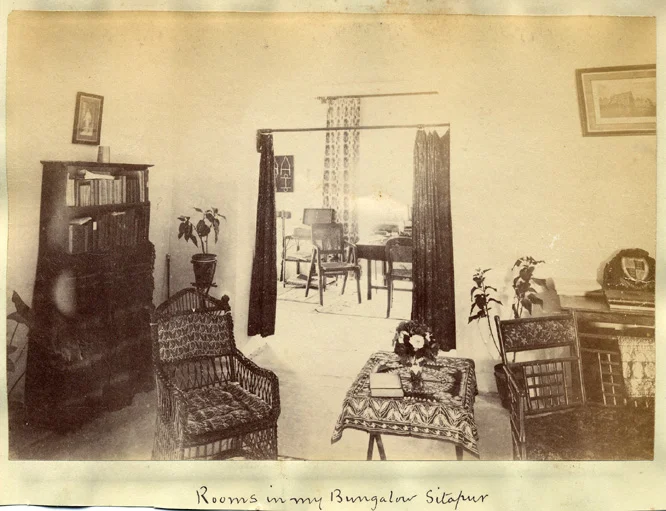




"Incidents in a Young Civilian's First Year in India," from the Illustrated London News, 1888; very large scans of this engraving from my own collection: *upper half*; *lower half*

My sitting room, Gorakhpur 1893"*

*In a coach drawn by four horses; a photo from the 1890's*

*"Life in and about an Indian bungalow," from The Graphic, 1895*
After the British forces defeated and captured Thibaw, the erudite king of Burma (Myanmar) in 1885, they shipped him first to Madras and then Ratnagiri to prevent a possible revolt back home. The rented bungalow where he was placed under house arrest was unfit for a king and the British permitted him to build a royal residence for himself. The king supervised the construction of Thibaw Palace every day till 1910 and both he and his wife breathed their last in the same building. Built out of laterite, mortar and Burmese teak, the majestic brick red palace on a grassy embankment had a small museum dedicated to the king.


A British Bungalow-1876 India


"Our caravan, Rajasthan"

"Our encampment at Rajpoor"*;

Our Gwalior escort"*

"The Rajah of Bunera visiting the travellers"*

*"Mountain travelling in India--the shortest way down the Coonoor Ghaut," from The Graphic, 1881*

*"Christmas in Southern India," from The Graphic, 1884*

The Ajmer Bungalow is in the Civil Lines area of Ajmer City.
Built in 1908, it is a typical British colonial bungalow, standing in its own grounds. With a varied roof line which hints at cool, high-ceilinged interiors protected from the hot desert air by thick walls and deep, shaded verandas....
Built in 1908, it is a typical British colonial bungalow, standing in its own grounds. With a varied roof line which hints at cool, high-ceilinged interiors protected from the hot desert air by thick walls and deep, shaded verandas....

This was indeed a majestic building dating back to the 18th Century, built by the Danish East India Company in what was once a pepper trading post of Tranquebar. The Tamil village of Tharangambadi, which translate to ?The Singing Waves?, was once a Danish colony set up by Adminral Ove Gedde with a sea fort ?Dansborg? and several Lutheran Protestant Churches was once a flourishing sea port and centre of pepper trade. This bungalow, situated at the end of the King?s Street, past the Memorial of the Lutheran Protestant evangelist Bartholomaus Ziegenblog,>[now converted into a hotel] ,see below

 Bernard bungalow an old British bungalow Cochin ,converted into hotel
Bernard bungalow an old British bungalow Cochin ,converted into hotel
This photo of Hotel Ros Common was an old British bungalow,Mall Road, Kasauli 173204, India-now a hotel

This photo of Hotel Ros Common

Traveller's Bungalow-Antique Print 1850,see the hand pulled fan(punkah) on top.Indian servants are coming with drinks for the rare tourist British sahib
Below photo of another tourist bungalow ,with British officers enjoying the lonely life in India ,under a hand pulled cloth punkah(fan)
below you can see the old "DINNER WAGON" so called kitchen cabinet of British era

 parlor
parlor
Library,
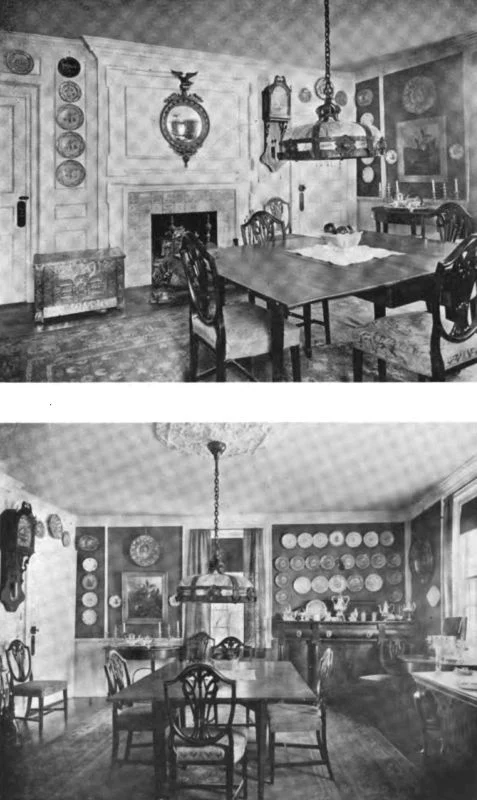
Two Views of the Dining Room,-
below painting 1850 shows
British Doctor in India, British Raj, Antique Lithograph,

below painting shows British family in India 1860's,punkah man{fan cord puller}is on his knees busy pulling the cloth fan on top ;while another servant is serving drinks

Sinna Dorai"bungalow - an assistant manager to the populace of a South Indian tea plantation[sinna means small/assistant and dorai means white man in colonial language]


Typical Colonial Bungalow of white ruler in India

lunch party for fifteen people at the Gyantse Dak Bungalow on July 1st 1927. This photograph was taken on that occasion

indian soldiers attacking a european bungalow 1857

![[British_in_India_1878.jpg]](https://blogger.googleusercontent.com/img/b/R29vZ2xl/AVvXsEjHSgcPS_SwQAOwQa9KD_kEeAjoGfFEadKW4kM9nlGDAQVTSXzFIPZ_udydYn9PnUMFIRS0fw3nO1ERGrzEB1FiwYrDP5UPJeMdGFkOUciTL50WLuRjRzc8KXnQIp8tSg7zgsz3w7t2gIOT/s1600-rw/British_in_India_1878.jpg)
below:- life in bungalows



hand pulled punkah(fan) hanging above can be seen
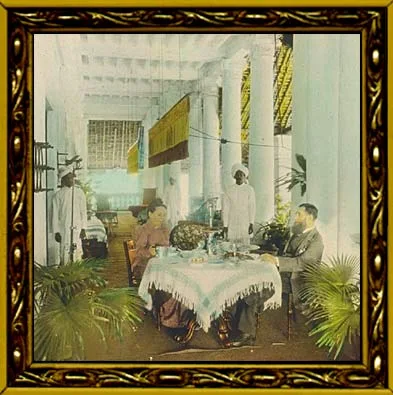

This photo of Red Hill Nature Resort British bungalow
below:-learning horse riding -British India
below:- mostly it was a lonely life for the British
Below:- British bungalow 1920
below:- hunting dogs and horses.hunting was an important part of British life in India
below:- British army officer and Indian soldiers .Indians were not allowed to be senior officers or commanders ,after the 1857 Indian revolt
below:- British officer [with both legs up on easy chair] ,while the khansamah(cook) opens a bottle of whiskey
Beating the heat and ruling India
Cooling tales from the Raj by Pran Nevile
 An English family at dinner under a hanging punkah. Drawing by Sir Charles D’oyly c. 1810 |
The heat of the Indian summers scared the English.
Before the advent of punkhas and American ice in early the 19th century, the English dreaded the oppressive heat and miseries of the hot season.
Before the advent of punkhas and American ice in early the 19th century, the English dreaded the oppressive heat and miseries of the hot season.
One of the earliest comments on the Indian summer was recorded by an English surgeon in 1774. He refers to his horrible experience of a sultry day "when not a breath of air was there for many hours; man and every fowl of the air so sensibly felt it that some species fell down dead". The heat, dust and hot winds and the awful devastation they caused earned them the title of "angels of death" by many a memsahib in her letters home.
It was even jokingly remarked that the deadly heat of Calcutta was more dangerous to British life than any uprising by the natives.
It was even jokingly remarked that the deadly heat of Calcutta was more dangerous to British life than any uprising by the natives.
An amusing tool to battle the heat as recommended to the sahibs by the English editor of Calcutta Gazette in 1783 was to sleep with Indian women to keep themselves cool in the beastly summer of Calcutta. The Portuguese actually secured a firman from Emperor Shahjahan to keep Bengali women during summer to save themselves from the heat of the delta.
The early British settlers in the 18th century used to wear loose fitting and airy cotton garments at home suitable for the hot climate. Later, however, in the light of increasing political power and prestige they began wearing clothing designed for the English climate which was completely unsuitable for the Indian summer. Their attire and the habit of excessive consumption of alcohol were not conducive to alleviate the effects of the heat.
Building defence
As a protection against the hot Indian climate, the English built their bungalows within compounds of shady trees and the rooms had very thick walls and high ceilings surrounded by covered verandas.
Some wealthy high-ranking sahibs in Calcutta even maintained garden houses on the banks of the river. Some British officials like Metcalfe

and William Fraser, in Delhi followed the Mughal practice and built tehkhanas-Tehkhana literally means basement. In the olden days, tehkhanas served as prisons or were used to store treasures] in their residences where they entertained their guests.
Some wealthy high-ranking sahibs in Calcutta even maintained garden houses on the banks of the river. Some British officials like Metcalfe
| Sir Thomas Metcalfe, Bt | |
|---|---|
 Sir Thomas Metcalfe, Bt, on a picture from the Delhi Book |

and William Fraser, in Delhi followed the Mughal practice and built tehkhanas-Tehkhana literally means basement. In the olden days, tehkhanas served as prisons or were used to store treasures] in their residences where they entertained their guests.

Another novel feature of the English bungalows was the terrace or housetop accessible through a winding staircase from without and often from within the house also. Many sahibs, especially bachelors, had their cots carried to the housetop during the hot season, and there, with heaven as their canopy, they slept during the night.
Some sahibs would set up special enclosures on the terrace and put their cots over there. Colesworthy even writes about a person known to him, who used to sleep on the bare terrace with nothing except a pillow and would remain lying there even when it rained. We come across an interesting case of a young Company civilian who beat the heat by lying down on a cot with a mushq for a pillow and the contents of a secondmushq poured over him.
There were others who slept in sheets which had been previously soaked in water. As it was unbearable to sleep indoors during the hot weather, some of them selected open spaces in their compounds.
There were others who slept in sheets which had been previously soaked in water. As it was unbearable to sleep indoors during the hot weather, some of them selected open spaces in their compounds.
An indigenous cooling device adopted by the sahibs was the installation of tatties made of khus-khus grass over all openings — windows and doors — of a house. Tatties were kept continually wet by a bhishtee,
bhishtee,or a water carrier,
or a water carrier, engaged to throw water against these from outside.

Tatties[MAT] made of khus khus Summer Curtain Made with Vetiver Roots
This was very effective in cooling when winds, hot or cool, blew. The rapid evaporation of sprinkled water and the refreshing odour of khus-khus made the inner spaces both cool and comfortable. The khus-khus tatties were highly valued in the upper provinces, which had far more hot winds than in Calcutta.
The use of tatties, however, was also prevalent during the Mughal times and the invention of this device is attributed to the Mughal emperor Akbar.
bhishtee,or a water carrier,
or a water carrier, engaged to throw water against these from outside.

Tatties[MAT] made of khus khus Summer Curtain Made with Vetiver Roots
This was very effective in cooling when winds, hot or cool, blew. The rapid evaporation of sprinkled water and the refreshing odour of khus-khus made the inner spaces both cool and comfortable. The khus-khus tatties were highly valued in the upper provinces, which had far more hot winds than in Calcutta.
The use of tatties, however, was also prevalent during the Mughal times and the invention of this device is attributed to the Mughal emperor Akbar.
Punkah perfect
The punkah bears the stamp of the Orient and the tropics. The use of hand punkha dates from olden times. There were many different kinds and sizes of the hand punkha. These were waved to and fro by servants called punkhawalas. There is also a mention of hand fans made of peacock tails and feathers in South India where servants also held umbrellas over their masters.
The hanging punkha suspended from the ceiling was introduced towards the end of the 18th century. Col Yule in Hobson Jobson refers to the use of this device by the Arabs and attributes its invention to Caliph Mansur (AD 753-74). It was known as the Marwaha al Khaish (linen fan). There is no reference to swinging punkah in Mughal India or in the East India Company records until 1780.
The hanging punkha suspended from the ceiling was introduced towards the end of the 18th century. Col Yule in Hobson Jobson refers to the use of this device by the Arabs and attributes its invention to Caliph Mansur (AD 753-74). It was known as the Marwaha al Khaish (linen fan). There is no reference to swinging punkah in Mughal India or in the East India Company records until 1780.
William Hicky in 1785 records the luxury of hanging fans while sahibs were having their meals. It is a French seaman — Captain de Grandpre’ — who first describes the Calcutta punkha in 1790. "In many houses, there was a large fan, hanging from the ceiling over the eating table, of a square form and balanced on an axle fitted to the upper part of it. A servant standing at one end of it, puts it in motion by means of a cord which is fastened to it in the same manner as he would ring a bell".


According to one authority, hanging punkhas were accidentally invented by a Eurasian clerk in Calcutta when he suspended the leaf of a table which was waved by a visitor to and fro resulting in a breath of cool air, which suggested the idea of developing this device.
Besides the punkah, there was another mostly forgotten device used in some British homes for beating the heat called the ‘thermantidote’.
It was a huge box containing a revolving hand-operated fan like a steamboat’s paddle with tatties- fitted windows on each side. The hot air sucked in by this gadget passing through moist tatties filled the entire house with cool air, bringing relief to the memsahib, who would write home about various modes of cooling during the ghastly Indian summer. There is a mention of this novel device in the writings of Fanny Parks in 1831. This invention is attributed to Dr George Green Spilsbury, who came to India in 1823 and was, for some years, surgeon to the Saugor Political Agency.
 |
| MODERN DAY THERMANTIDOT OR AIR COOLER |
It was a huge box containing a revolving hand-operated fan like a steamboat’s paddle with tatties- fitted windows on each side. The hot air sucked in by this gadget passing through moist tatties filled the entire house with cool air, bringing relief to the memsahib, who would write home about various modes of cooling during the ghastly Indian summer. There is a mention of this novel device in the writings of Fanny Parks in 1831. This invention is attributed to Dr George Green Spilsbury, who came to India in 1823 and was, for some years, surgeon to the Saugor Political Agency.
Before the introduction of ice, an important servant of the sahib’s household was the Abdar. He was entrusted with the job of cooling the water, wines, beer and other table delicacies, which depended more on their refreshing coolness than flavour for value and acceptance. He was the walking refrigerator of those days and went with his master to every dinner party for cooling the master’s wine, using saltpetre in a container for the bottle.
Imported ice
 Icepits near Allahabad. Drawing by Fanny Parks c. 1830 |
The introduction of American ice in 1833 was an event of great jubilation and feasting in Calcutta. The American ice replaced the mountain ice brought down at heavy cost and inconvenience, and the other
native ice produced in ice pits
during winter nights and preserved for the summer, entailing colossal wastage. Small earthen pots filled with water were placed in an open field, and in the morning the coating of ice formed in the cold temperature of the night was collected and stored in ice-pits.
It was after more than 20 years of experiment in the early 19th century that an American entrepreneur, Fredrick Tudor, succeeded in transporting ice from a cold to a hot climate.
The ice blocks cut from the frozen ponds rented near Boston were stored in an icehouse before loading them on board the vessel, which had an in-built icehouse.
The first shipment of American ice
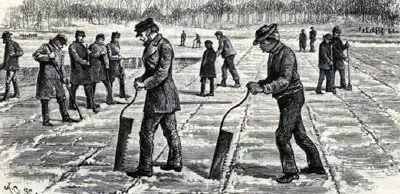
arrived in Calcutta by S.S. Tussany in September, 1833,

after a four-month voyage around the Cape. Wrapped in felt and pine saw dust, two-thirds of the ice cargo in solid form was received with great excitement in Calcutta. So much so that the Governor-General Lord Bentinck

presented an inscribed silver-gilt cup to the ship’s captain William C. Rogers for having successfully landed the first shipment of American ice in India.
This encouraged the exporter Fredrick Tudor

to make ice shipments to Bombay and Madras also. Icehouses were soon constructed at all three ports to store the precious ice cargo and preserve it against heat.
There was a growing demand for this crystal clear ice among the local European population as well as wealthy Indians. Selling at four annas a seer, half the price of Indian ice, the American ice became popular with all who could afford it.
Tudor made a fortune by carrying on this ice trade for over 30 years till the technology of making ice was introduced in India.
The first shipment of American ice

arrived in Calcutta by S.S. Tussany in September, 1833,

Icemen, on the rocks.
after a four-month voyage around the Cape. Wrapped in felt and pine saw dust, two-thirds of the ice cargo in solid form was received with great excitement in Calcutta. So much so that the Governor-General Lord Bentinck

presented an inscribed silver-gilt cup to the ship’s captain William C. Rogers for having successfully landed the first shipment of American ice in India.
This encouraged the exporter Fredrick Tudor

to make ice shipments to Bombay and Madras also. Icehouses were soon constructed at all three ports to store the precious ice cargo and preserve it against heat.
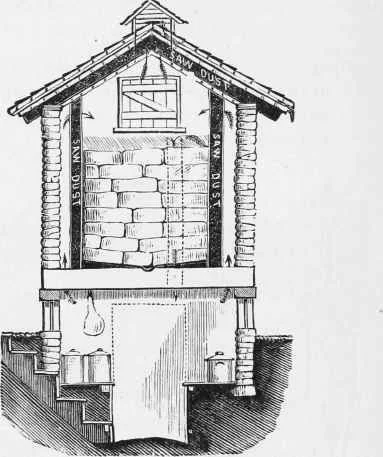 |
| ICE STORAGE HOUSE 19 TH CENTURY |
There was a growing demand for this crystal clear ice among the local European population as well as wealthy Indians. Selling at four annas a seer, half the price of Indian ice, the American ice became popular with all who could afford it.
Tudor made a fortune by carrying on this ice trade for over 30 years till the technology of making ice was introduced in India.
Super sola
Another useful device, which served as a shield against the killer sun of the tropics was the sola topi.


People had used various kinds of head covers for protection against the sun’s rays.
It was after 1857 that the sola topi attained its supremacy and eliminated all other kinds of sun hats. It became even a symbol of the Imperial might as no sahib ever appeared in public without a hat. They wore them even during the rain and some sahibs got them enamelled to make them waterproof.


People had used various kinds of head covers for protection against the sun’s rays.
It was after 1857 that the sola topi attained its supremacy and eliminated all other kinds of sun hats. It became even a symbol of the Imperial might as no sahib ever appeared in public without a hat. They wore them even during the rain and some sahibs got them enamelled to make them waterproof.
The heat, no doubt, haunted the English and even determined their life-style in India. After consolidating their hold on major parts of India,
they created their "little Englands" at the hill stations with English-style cottages. These relics of the Raj with their cool climate, lush greenery and glorious views of snow-covered peaks offered a pleasant escape from the grilling heat of the plains.
Simla, the pride of the`Raj, became the summer capital of India from 1830 followed by Ooty for Madras, Nainital for Lucknow, Mahableshwar for Bombay and Darjeeling for Calcutta.
they created their "little Englands" at the hill stations with English-style cottages. These relics of the Raj with their cool climate, lush greenery and glorious views of snow-covered peaks offered a pleasant escape from the grilling heat of the plains.
Simla, the pride of the`Raj, became the summer capital of India from 1830 followed by Ooty for Madras, Nainital for Lucknow, Mahableshwar for Bombay and Darjeeling for Calcutta.
With their holiday atmosphere enriched by picnics and parties in the cool and picturesque surroundings, the hill stations provided an escape from the heat, a refuge for the invalid and the bored and a fun place for the pleasure seekers, both sahibs and memsahibs.
Emily Eden, sister of Governor-General Auckland, described Simla as "the nearest place to dear home that one could hope for in this dreadful country".
From 1864, Simla became the seat of the government from April till October, and the ruling elite and their staff would move en bloc from Calcutta to run the administration from there. With Kipling’s writings, Simla acquired a reputation for merriment, gaiety, high living and not so harmless flirting. Nevertheless, the hill stations became popular centres for rest and recreation in summer, especially for memsahibs, who supposedly wilted under the heat much more rapidly than their men folk.
EACH BRITISH FAMILY HAD MANY SERVANTSEmily Eden, sister of Governor-General Auckland, described Simla as "the nearest place to dear home that one could hope for in this dreadful country".
From 1864, Simla became the seat of the government from April till October, and the ruling elite and their staff would move en bloc from Calcutta to run the administration from there. With Kipling’s writings, Simla acquired a reputation for merriment, gaiety, high living and not so harmless flirting. Nevertheless, the hill stations became popular centres for rest and recreation in summer, especially for memsahibs, who supposedly wilted under the heat much more rapidly than their men folk.
........................................................................................................................................................
BRITISH COLONIAL FURNITURE
Related searches
tropical british colonial style
british colonial furniture
modern british colonial decor
Related searches
colonial furniture sketch
british colonial style kitchen
british colonial india interior design
Related searches
tropical british colonial decor
tropical british colonial living room
antique colonial furniture
Related searches
british colonial style furniture
british colonial houses in india
british colonial interior design
Related searches
tropical british colonial style
british colonial furniture
modern british colonial decor
Related searches
colonial furniture sketch
british colonial style kitchen
british colonial india interior design









